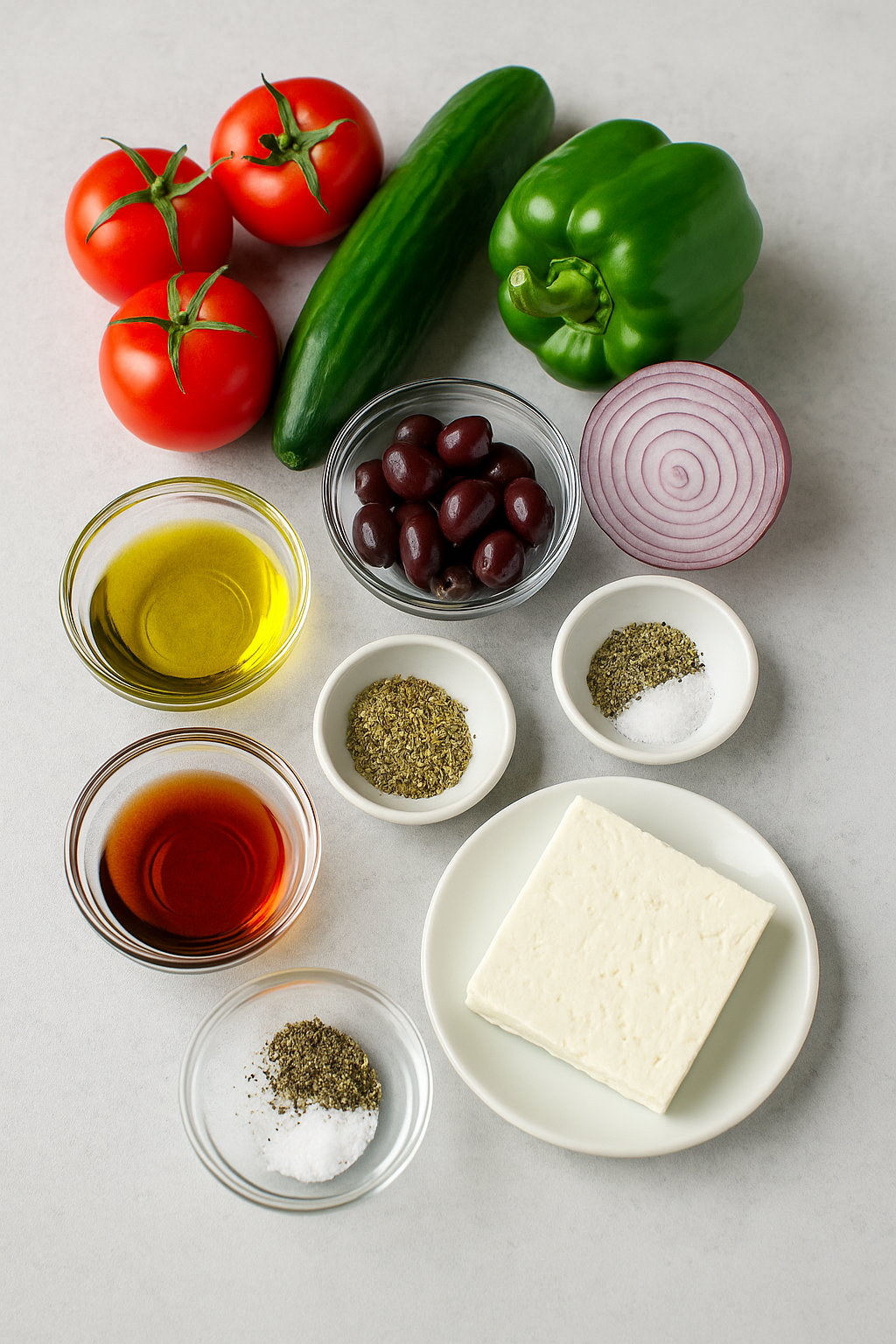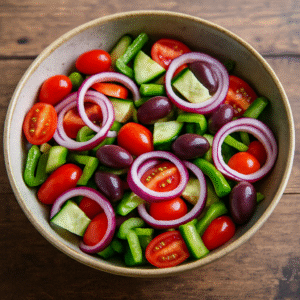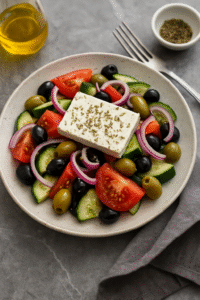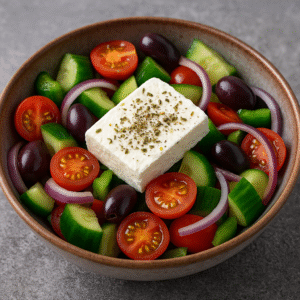Introduction
Greek Salad, also known as Horiatiki, is one of the most famous dishes in Mediterranean cuisine. Made with fresh vegetables, briny Kalamata olives, and creamy feta cheese, this salad is simple, healthy, and full of flavor. The beauty of Greek Salad lies in its balance: juicy tomatoes add sweetness, cucumbers bring crunch, onions and peppers offer sharpness, while olives and feta create richness and depth.
This dish is more than just a salad — it represents the Mediterranean lifestyle. Traditionally, Greek Salad is served as a side dish alongside grilled meats or seafood, but it is equally satisfying as a light main course on a hot summer day. Its popularity has spread worldwide because it is quick to prepare, nutritious, and incredibly versatile.
The key to an authentic Greek Salad is using high-quality ingredients. Always choose ripe tomatoes, crisp cucumbers, extra virgin olive oil, and block feta cheese made from sheep’s milk. Pre-crumbled feta or low-quality olive oil will never deliver the same authentic taste. With just a few ingredients, you can bring the sunshine of Greece right into your kitchen.
Table of Contents

Greek Salad (Authentic Horiatiki Recipe)
Ingredients
Equipment
Method
- Prepare the vegetables: cut tomatoes into wedges, slice cucumber, onion, and bell pepper.
- In a large salad bowl, combine tomatoes, cucumber, onion, bell pepper, and Kalamata olives.

- Place a block of feta cheese on top of the vegetables.

- Drizzle with olive oil and red wine vinegar.
- Sprinkle dried oregano, season with salt and pepper.
- Toss gently before serving or serve as is with feta on top.

Notes
- Always use block feta, not pre-crumbled, for authentic flavor.
- Red wine vinegar gives the best taste, but lemon juice can be used.
- You can add capers for an extra Mediterranean twist.
Recommended Products for Greek Salad
- 🫒 Kalamata Olives
- 🧀 Feta Cheese Block
- 🫗 Greek Extra Virgin Olive Oil
- 🍾 Red Wine Vinegar
- 🥣 Large Glass Salad Bowl (Pyrex)
Tips & Tricks
To make the best Greek Salad, keep these tips in mind:
- Use block feta, not crumbled: A solid block of feta on top of the salad is traditional and adds a rustic, authentic look. Crumbled feta often loses flavor and texture.
- Chill your vegetables: Cold, crisp vegetables make the salad more refreshing, especially on hot days.
- Don’t overdress: Greek Salad should be lightly dressed with olive oil and red wine vinegar. Heavy dressings cover up the natural flavors.
- Add herbs carefully: Dried oregano is classic, but you can also add fresh parsley or mint for a twist. Keep it light so the feta and olives shine.
- Serve immediately: This salad tastes best right after it’s made, when the vegetables are fresh and crunchy.
Storage & Reheating
Greek Salad is best enjoyed fresh, but if you need to store it, follow these tips:
- Refrigerator: Place leftovers in an airtight container. It will keep for up to 24 hours. The vegetables will release some liquid, so stir before serving.
- Separate components: For longer freshness, keep the feta block and dressing separate. Add them right before serving to keep the salad crisp.
- Do not freeze: Greek Salad should never be frozen. Freezing ruins the texture of the vegetables and cheese.
- Revive before serving: If the salad has been stored, drizzle a little extra olive oil and sprinkle oregano before serving to refresh the flavors.
Conclusion
Greek Salad is more than a recipe — it is a celebration of Mediterranean simplicity and flavor. With just a handful of fresh ingredients, you can create a dish that is healthy, vibrant, and satisfying. Whether you serve it as a side dish with grilled chicken, pair it with warm pita bread, or enjoy it alone on a hot summer day, Greek Salad never disappoints.
The combination of sweet tomatoes, crisp cucumbers, briny olives, and creamy feta cheese makes it one of the most balanced and refreshing salads in the world. If you are looking for a quick meal that is both nutritious and delicious, this recipe should always be on your list.
For more Mediterranean classics, don’t miss our Risotto alla Milanese or Pizza Margherita. These dishes, together with Greek Salad, showcase the true essence of Mediterranean cooking — fresh ingredients, bold flavors, and simple techniques.
Greek Salad is also recognized internationally as one of the most iconic Mediterranean dishes. According to Wikipedia, the authentic version (Horiatiki salata) does not include lettuce and is always served with a block of feta on top. This salad reflects the Greek philosophy of simple, seasonal eating, using fresh produce and minimal preparation to highlight natural flavors.


